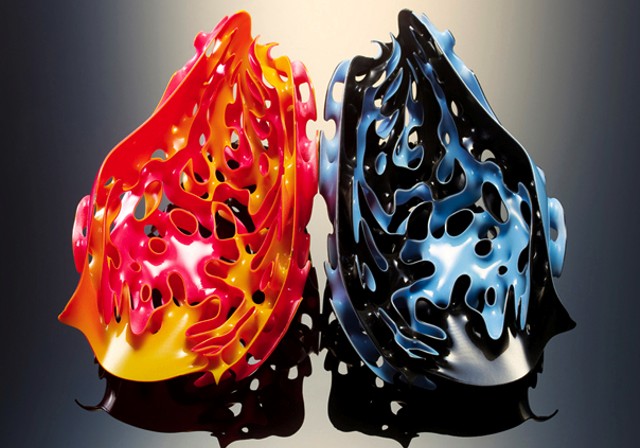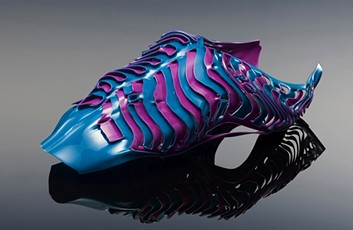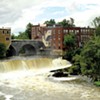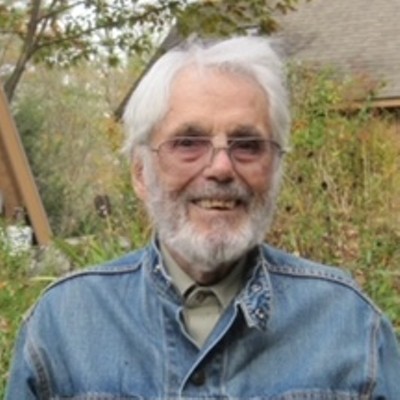
- Yoram Reshef
- Pneuma 1, by Neri Oxman | 3D printed models produced by Stratasys
Neri Oxman’s creations look like they’ve emerged from a 1950s science-fiction film. Multicolored, alien crenellations bend into weird but oddly recognizable shapes; weird textures evoke deep-sea creatures or weird insects. They’re extremely difficult to figure out.
But that inscrutable nature is by design. Just as Oxman’s projects look both bizarre and familiar, she resists easy categorization herself. Part artist, part scientist and part designer, Oxman works in a field that’s she’s dubbed “
material ecology,” the goal of which is to study how new techniques of design and fabrication can transform the creation of everyday objects and structures. As she put it on her blog, her overall project is to investigate the ways that design intersects with “architecture, enginerring, computation, and ecology.”
Many of Oxman’s most striking designs draw their inspiration from natural materials: internal organs, insect carapaces, seashells. Oxman, a professor at MIT, is at the cutting edge of the 3-D printing revolution, and has used the technology to design and build everything from bike helmets to high-fashion dresses to carpal-tunnel wristguards.
Neri Oxman will visit the University of Vermont this Thursday to deliver the George D. Aiken Lecture, “Material Ecology: A New Approach to Nature-Inspired Design and Engineering.” By email, she answered some questions for
Seven Days in advance of her talk.
click to enlarge 
SEVEN DAYS: Your career path suggests that you don't pay much heed to disciplinary boundaries: You're an architect, a designer, an artist, a scientist. Did you set out to break boundaries, or were you led to do so by your many interests? Do you feel that such boundaries/labels restrict our achievements?
NERI OXMAN: Disciplinary boundaries are like borders between countries, no? For each a currency, a language, and a worldview; they exist to be traveled, trespassed. Like borders between countries disciplines are identified by what they contain. Without them, identity is lost. But these borders can only be perceived from above and are mostly hidden to those who do not like to travel. Good designers are also good travelers, and the quality of our creations is very much inspired and enabled by our ability to view and perceive the world from multiple angles and across scales. All great inventions and great works of art share this in common: They involve a unique way of seeing, perceiving and expressing.
SD: How do you keep an eye toward sustainability in your designs?
NO: I view the concept of sustainability as being an integral part of design, not external to it. Separating between design and its relation to the environment breeds a utilitarian approach to design where form, function and environment are considered as hierarchical, as elements designed to serve each other. But the tree doesn’t distinguish between its branching patterns, how much water transpires through its leaves and the amount of carbon dioxide it exchanges with the atmosphere. This very tree may even reveal deep secrets about the state of its forest. Nature does not separate between form and function; they are linked to the point where they can actively affect each other. Material ecology is our attempt at unifying computation, digital fabrication and the material itself as inseparable and harmonized dimensions of design.
click to enlarge 
- Yoram Reshef
- Leviathan 1, by Neri Oxman | 3D printed models produced by Stratasys
SD: Much of your work is beautiful, but also purpose-built. Do you ever have trouble reconciling these two ends?
NO: This very question can be asked about Nature herself. Nature as well as vernacular architecture are full of examples where beauty and function go hand in hand. Imagine the way in which the human spongy bone forms over time, or consider the craft of thatching. They are both characterized by very simple rules linking material to geometry, geometry to structure, structure to function and function to the environment.
And in both of those examples it is quite challenging, if not impossible, to distinguish between beauty and purpose. All of this to say: The moment we generate a choice between beauty and utility is the moment we compromise our calling as designers.
INFO
Neri Oxman’s Aiken Lecture, “Material Ecology: A New Approach to Nature-Inspired Design and Engineering,” takes place Thursday, October 2, 5 p.m., at Ira Allen Chapel, University of Vermont in Burlington. Free.
learn.uvm.edu/aiken



















































